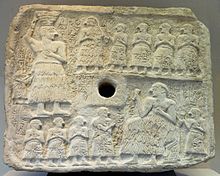Consecration plate

As Weihplatten in the be Near Eastern Archeology nearly square slabs of 8-50 cm on a side from the 3rd millennium BC. Chr., Which have a hole in the middle. They are mostly decorated in raised relief; but there are also occasionally incised, text-only or completely undecorated copies. Dedication plates have been found almost exclusively in temple districts, most of them in cities in southern Mesopotamia . They were probably set into the walls of the temples and belonged to the temple furnishings as offerings from rulers and members of the elite. A little more than 100 consecration plates (including fragments) have been published so far. They come from the Sumerian cities of Ur , Girsu , Umma , Larsa , Umm-al-'Aqāriba, Nippur , Ešnunna , Tutub , Tell Agrab , but also from some cities in northern Mesopotamia and Syria, such as Assur , Mari , Ebla and Tuttul . As yet unpublished dedicatory plates from Nippur and the sites in the Diyala area are mentioned in the research literature.
presentation

The image area bordered by a bar is usually divided into three horizontal registers in the older-early dynastic consecration plates, the middle one being interrupted by the perforation. Banquet scenes, festival preparations, musicians, wrestlers, chariots, animal fighting scenes or boats are shown. From the younger-early dynastic period onwards, the founders themselves are often depicted, either alone or with other family members, whereby the register division is increasingly being abandoned. From this time on, the dedicatory plates are regularly provided with dedicatory inscriptions, in which reference is made to the construction or decoration of the temple. From the Akkadian period , dedicatory inscriptions regularly refer to the life of the founder or his ruler. Akkadian and New Sumerian consecration plates often only have an engraved inscription in Sumerian or Akkadian language .
Example of a donor inscription
| originally d Nanse | Ur-Nanše, |
| lugal-lagaš | the king of Lagaš , |
| dumu-gu-NI.DU | the son of Gunidu, |
| dumu-gur-sar | the son of Gursar, |
| é- d Nin-gír-su | has the temple of Ningirsu |
| mu-dù | built, |
| ab-bàn-da | has the Abzubanda |
| mu-dù | built, |
| é- d Nanše | has the temple of Nanše |
| mu-dù | built. |
Dating
The oldest well-dated ornate consecration plates come from layers of the early early dynastic period (approx. 2800 BC) in Ešnunna . The tradition of their consecration continues until the Ur-III period . The most recent inscription dated dedication plate with an inscription by Amar-Suena of Ur (2046–2038 BC) was found in northern Mesopotamian Assyria .
function
Not a single consecration plaque was found in situ . The basic shape and the less carefully worked edge zone with several fastening holes, which in some cases extends beyond the picture frame, clearly speak in favor of vertical attachment to mud brick walls. The areas outside of the picture frame are likely to have been under the plastering of the wall and not have been visible. A stake or nail was probably driven into the wall through the hole in the middle of the votive plate. With the help of this stake a door could be locked and the clay lock sealed. Imprints on the back of door locks made of Nippur from the original III period attest to this attachment, at least for this late period of the consecration plates.
Benefactor

Insofar as the consecration plaques are provided with inscriptions, these come predominantly from rulers who usually refer to the construction or decoration of the temple in which the consecration plaque was attached. At least these specimens should therefore have belonged to the original furnishings of the temple. According to the inscriptions, consecration took place more often for the life of the founder or his overlord from the younger-early dynastic period. These panels can therefore also have been donated to an already existing building. In addition to rulers, members of the royal family, but also priests, clerks, craftsmen and, in one case, a wholesale merchant are proven donors.
literature
- Donald P. Hansen : New Votive Plaques from Nippur. In: Journal of Near Eastern Studies Volume 22, 1963, pp. 145-166.
- Johannes Boese : Old Mesopotamian consecration plates. A Sumerian type of monument from the 3rd millennium BC Chr. (= Studies on Assyriology and Near Eastern Archeology. Volume 6). Walter de Gruyter, Berlin / New York 1971, ISBN 3-11-002484-5 .
- Richard L. Zettler: Sealings as Artifacts of Institutional Administration in Ancient Mesopotamia. In: Journal of Cuneiform Studies . Volume 39, 1987, pp. 197-240.
- Eva-Andrea Braun-Holzinger: Mesopotamian votive offerings from the early Dynastic to the Old Babylonian period (= Heidelberg Studies on the Ancient Orient. Volume 3). Heidelberger Orientverlag, Heidelberg 1991, ISBN 3-927552-02-X , pp. 303-318.
- Eva Strommenger , Peter A. Miglus : Excavations in Tall Bi'a / Tuttul V: Small ancient finds (= scientific publications of the German Orient Society. Volume 126). Harrassowitz, Wiesbaden 2010, ISBN 978-3-447-06169-8 .
- Jean M. Evans: votive plaque. In: Michael P. Streck (ed.): Reallexikon der Assyriologie und Vorderasiatischen Aräologie . Volume 15, Walter de Gruyter, Berlin / Boston 2016–2018, ISBN 978-3-11-046218-0 , pp. 35–37.
Individual evidence
- ↑ Evans: Weihplatte, p. 36
- ↑ Strommenger / Miglus, Kleinfunde, p. 157, plate 179, 2.
- ↑ Evans: Weihplatte, p. 37
- ↑ according to Braun-Holzinger: Consecrations, p. 308
- ↑ Evans: Weihplatte, p. 36
- ↑ Braun-Holzinger: Consecrations, pp. 316-17
- ↑ Boese: Weihplatten, pp. 143–51
- ↑ Zettler: Sealings, p 211
- ↑ Braun-Holzinger: Consecrations, p. 306
- ↑ Braun-Holzinger: Consecrations, pp. 308-17